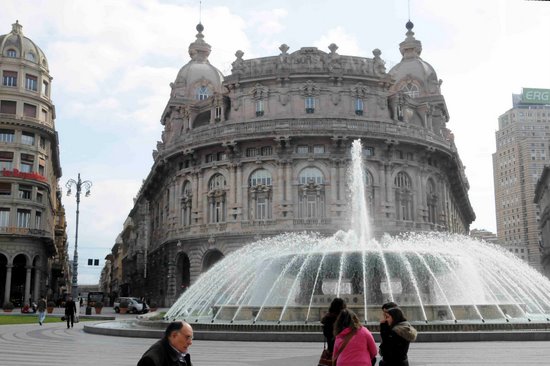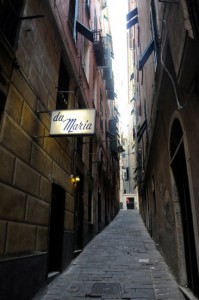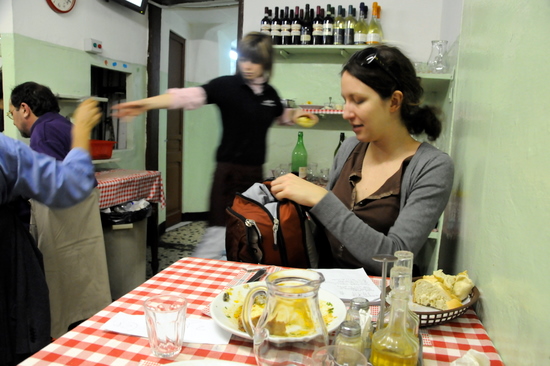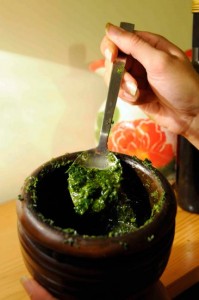The Italian city of Genoa is not recognized for its beauty. Its massive industrial port blocks views of the Mediterranean, and I wouldn’t recommend getting too close: the strong stench of fish and diesel is enough to keep even old salty dogs onshore. Before I went to Genoa, a friend described it to me as the “armpit of Italy.”  There is one good reason to visit Genoa, however. It is an extremely delicious reason, and consists of a single word: pesto.
There is one good reason to visit Genoa, however. It is an extremely delicious reason, and consists of a single word: pesto.
My girlfriend, Kristin, likes to think of herself as the queen of pesto, partially because I call her that, but mostly because she makes incredible pesto. She can make it using a mortar and pestle, a Cuisinart, or a knife; basil, arugula, or parsley; walnuts, pine nuts, or almonds. Come to think of it, maybe I should start calling her the MacGyver of pesto? To feed her obsession, we decided to visit Genoa. We were traveling with loaded backpacks from Milan to Asti, but we decided to stop in Genoa, more than an hour and a half out of our way, for  lunch, just to taste pesto in the town in which it was invented.
lunch, just to taste pesto in the town in which it was invented.
Genoa is known as the birthplace of pesto, though every town in Italy seems to have its own style of pesto. Sicily has a pesto that is based on sun-dried tomatoes instead of basil, and Calabria has a pesto based on red peppers. But basil-based pesto, or Genovese pesto, has been made all over Italy for centuries. I believe that Genoa is known as the birthplace of pesto because of its surrounding farmland, which is particularly suited for growing high-quality basil.
 When we arrived, we stored our bags at the train station (tip: if you have two small bags, tie them together to avoid paying 4 euro for each bag) and headed toward the restaurant in Genoa famed for its traditional, no-frills Genovese pesto: Trattoria da Maria. It is hidden on a steep side street off of the main Via Garibaldi. The restaurant is as local as it gets: bustling, cramped, and located in what looks like an old two-story apartment. The tables are covered with red-checked tablecloths. Our waitress recited the day’s menu for us, although there are also written menus available upon request. Of course, we already knew what we wanted.
When we arrived, we stored our bags at the train station (tip: if you have two small bags, tie them together to avoid paying 4 euro for each bag) and headed toward the restaurant in Genoa famed for its traditional, no-frills Genovese pesto: Trattoria da Maria. It is hidden on a steep side street off of the main Via Garibaldi. The restaurant is as local as it gets: bustling, cramped, and located in what looks like an old two-story apartment. The tables are covered with red-checked tablecloths. Our waitress recited the day’s menu for us, although there are also written menus available upon request. Of course, we already knew what we wanted.
 When our steaming bowls arrived, we learned what real Genovese pesto is all about. A moderate dollop of pesto is placed on a pile of trenette pasta, very similar to linguine. As for the sauce, the basil is fresh and the consistency very light, making me believe that few nuts are used (and perhaps a bit of parsley). Though there was not a lot of pesto, it was enough to coat all the pasta, and neither Kristin nor I felt that we needed (and the operative word here is needed) more. The flavor was an affirmation of what we’d always thought pesto should be. The real surprise was the addition of a few pieces of boiled potato and a boiled green bean, traditional accompaniments of Genovese pesto.
When our steaming bowls arrived, we learned what real Genovese pesto is all about. A moderate dollop of pesto is placed on a pile of trenette pasta, very similar to linguine. As for the sauce, the basil is fresh and the consistency very light, making me believe that few nuts are used (and perhaps a bit of parsley). Though there was not a lot of pesto, it was enough to coat all the pasta, and neither Kristin nor I felt that we needed (and the operative word here is needed) more. The flavor was an affirmation of what we’d always thought pesto should be. The real surprise was the addition of a few pieces of boiled potato and a boiled green bean, traditional accompaniments of Genovese pesto.
 Since our trip to Genoa, we always include a little potato in our bowl of pesto, because it adds creaminess to the dish. Though it was only one lunch, my experience in Genoa has stayed with me; clearly, there is more to the port town than I thought.
Since our trip to Genoa, we always include a little potato in our bowl of pesto, because it adds creaminess to the dish. Though it was only one lunch, my experience in Genoa has stayed with me; clearly, there is more to the port town than I thought.


Comments